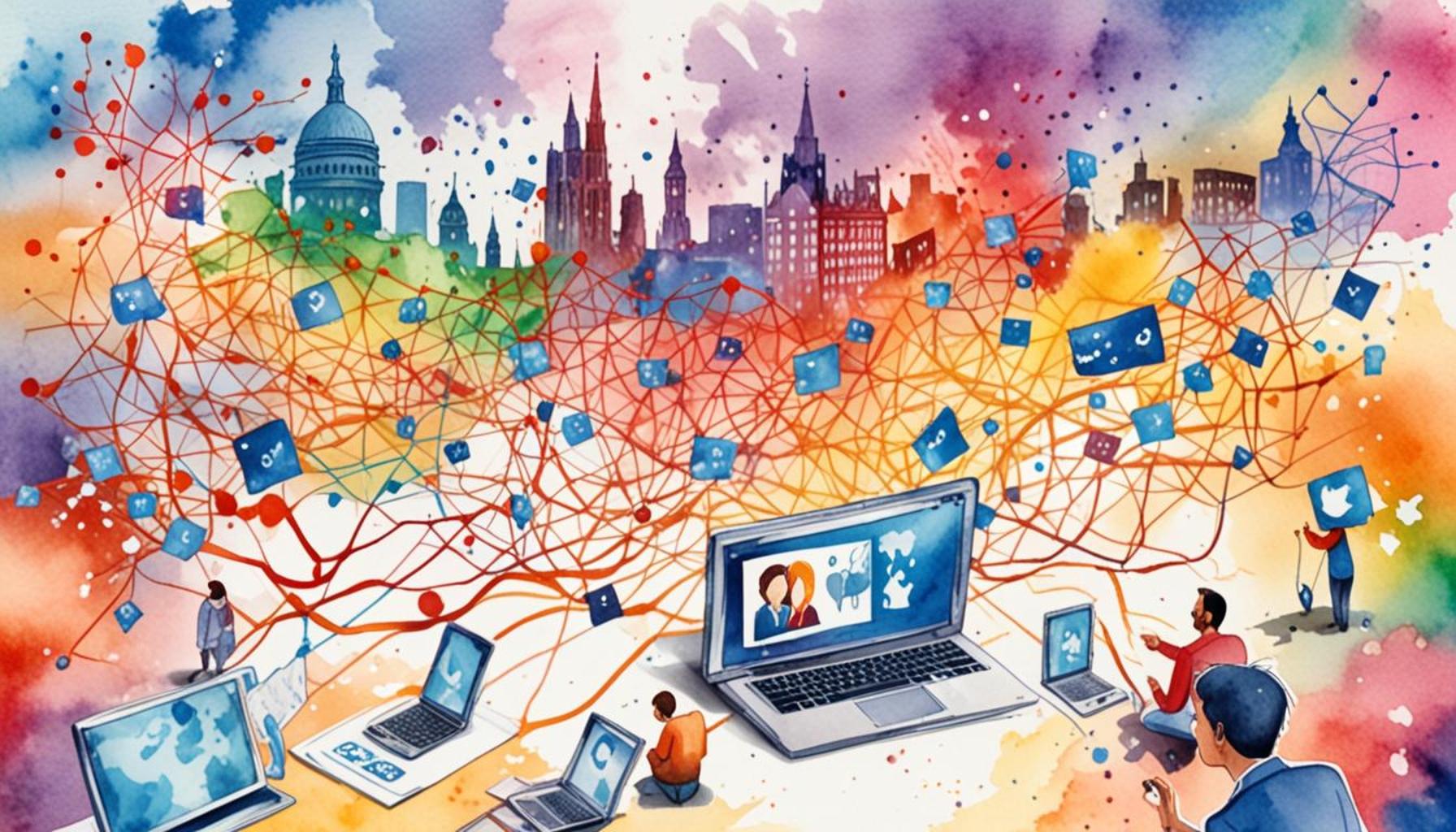The Role of Social Media in Promoting Online Government Benefits

Transforming Communication through Social Media
In the rapidly evolving landscape of the 21st century, social media platforms have transformed the way individuals communicate, share ideas, and access information. Particularly, these platforms have emerged as indispensable tools for government agencies striving to connect with the public regarding available benefits. With billions of users globally, platforms such as Facebook, Twitter, and Instagram have become virtual town halls, where information flows freely and promptly.
Immediate Updates and Timely Access
One significant advantage of using social media for government communication is the ability to provide immediate updates. For instance, during crises such as the COVID-19 pandemic, government agencies effectively utilized social media to convey real-time information about health benefits, vaccine availability, and financial assistance programs. This immediacy ensures that taxpayers are aware of crucial deadlines and eligibility criteria, allowing them to access benefits that can significantly enhance their quality of life.
Wider Reach to Diverse Demographics
Social media also facilitates a wider reach to various demographics, including marginalized communities who might struggle to access traditional forms of information dissemination, such as newspaper ads or mailed pamphlets. For example, younger populations—who are often more engaged online than through conventional media—can be informed about programs like the Supplemental Nutrition Assistance Program (SNAP) through targeted ads on Instagram or Snapchat. Furthermore, these platforms allow governments to create content in multiple languages, thus broadening accessibility for non-English speakers and ensuring that vital information is inclusive and available to all.
Fostering Engagement and Building Trust
Another pivotal aspect of social media is its ability to promote engagement and interaction. Unlike traditional forms of communication, social media allows for direct dialogue between government representatives and citizens. For example, Twitter Town Halls encourage users to ask questions about health care or financial aid, providing opportunities for officials to address concerns transparently. This two-way communication not only clarifies confusion but builds trust between the community and governmental bodies. As citizens feel heard and acknowledged, they are more likely to participate in government programs and services.
Research indicates that when social media campaigns are implemented effectively, the uptake rates for programs such as Medicaid and SNAP can increase significantly. One study highlighted that counties in the U.S. using Facebook ads to promote SNAP saw a 13% increase in applications during a specific outreach campaign. This shows that when people are informed correctly and timely, they are empowered to take action.
As we continue to explore the evolving intersection of social media and governmental outreach, the implications for public welfare are profound. The effectiveness of these strategies not only reshapes public access to vital government benefits but also redefines how we perceive and engage with our government in the digital age.
CHECK OUT: Click here to explore more
Leveraging Social Media for Greater Accessibility
One of the core functions of social media in promoting government benefits is its ability to enhance accessibility for citizens. Unlike traditional notices that may get lost in the shuffle, social media delivers concise information directly to users’ feeds, ensuring important updates are seen and read. For many Americans, the convenience of receiving real-time information on government programs through platforms they frequently engage with is invaluable. Furthermore, this direct access can effectively reduce barriers to finding essential resources.
Visual Storytelling to Illustrate Benefits
The use of visual storytelling has also proven to be a significant advantage of social media. Engaging graphics, infographics, and videos can convey complex information about government benefits in a more digestible format. For instance, a short animated video illustrating the steps to apply for unemployment benefits can clarify the process for many potential applicants. Additionally, social media allows for live Q&A sessions where government representatives can explain how specific programs work, making the information not only accessible but also engaging.
Utilizing Hashtags and Social Movements
Social media platforms harness the power of hashtags and viral trends to amplify awareness of government benefits. Campaigns utilizing popular hashtags, such as #SNAPMatters or #MedicaidAwareness, can easily reach wider audiences when shared by users seeking information about these assistance programs. This grassroots approach not only educates individuals but also motivates them to spread the word within their communities. Moreover, social media can serve as a launchpad for social movements that advocate for improved access to these benefits, fostering a sense of community around the cause.
Effective Targeting through Data Analytics
The data-driven nature of social media provides government agencies with tools to analyze engagement and target their outreach effectively. Through insights derived from user interactions, governments can identify which demographics require more information and adjust their strategies accordingly. This targeted approach can help direct resources toward specific populations, ensuring that benefits reach those who need them most. Key elements include:
- Behavioral targeting: Understanding user interactions can help craft messages that resonate with specific audiences.
- Demographic targeting: Tailoring messages to various age groups or cultural backgrounds expands the reach of important information.
- Feedback mechanisms: Gathering user feedback through polls and comments helps refine communication strategies and services offered.
In concluding this section, the integration of social media into the promotion of government benefits is not merely an enhancement—it is a necessary evolution. As agencies adapt to changing communication paradigms, the capacity to reach and inform citizens effectively continues to grow, creating pathways for increased participation in vital programs and services.
| Category | Details |
|---|---|
| Increased Accessibility | Social media platforms act as a bridge, connecting diverse populations to essential government services. |
| Real-time Information | Public updates on benefits and deadlines enhance citizen engagement and compliance. |
| Community Support | Social media fosters community forums where users share experiences and advice, enhancing support networks. |
| Targeted Outreach | Government agencies can tailor messages to specific demographics, ensuring that the right information reaches those who need it most. |
In the digital age, the potential for social media to transform access to government benefits cannot be overstated. The utilization of these platforms not only enhances the dissemination of vital information but also promotes an inclusive environment, empowering citizens to navigate available resources effectively. The strategic implementation of social media initiatives can thus serve as a powerful tool in bridging gaps between government services and the communities they aim to benefit, ensuring that essential programs are accessible to all.
YOU MAY ALSO LIKE: Read read another article
Building Trust and Transparency through Engagement
Another essential aspect of social media’s role in promoting government benefits is its ability to foster trust and transparency among citizens. In an era of skepticism towards government institutions, social media provides a platform for public officials to engage directly with the community. This two-way communication channel allows citizens to ask questions, express concerns, and receive immediate feedback, bridging the gap between bureaucracy and the public. Transparency is heightened when agencies share behind-the-scenes content, such as the decision-making process for benefit allocations, which demystifies governmental functions and builds public trust.
Real-time Updates and Crisis Management
Social media is invaluable in delivering real-time updates regarding government benefits, particularly during emergencies. For instance, during the COVID-19 pandemic, social media platforms became critical channels for sharing crucial information about relief programs, application processes, and deadlines. The rapid dissemination of updates ensured that citizens were aware of changing policies and available resources. Utilizing hashtags specific to crises, like #ReliefUpdate or #VaccineSupport, allowed agencies to consolidate information while ensuring that it reached those most affected by the situation.
Create Community Dynamics and Peer Support
Social media also cultivates community dynamics that empower citizens to support one another in navigating government benefits. Online forums and groups centered around specific assistance programs can serve as valuable resources for users to share their experiences and provide tips. Platforms such as Facebook and Reddit have thriving communities dedicated to discussing programs like the Supplemental Nutrition Assistance Program (SNAP) and housing assistance. These peer networks often encourage individuals to apply for benefits they may have otherwise disregarded due to misinformation or lack of understanding. By sharing personal stories and successes, community members can demystify processes, creating a sense of collective empowerment.
Collaborations with Influencers and Advocacy Groups
In the quest to promote government benefits through social media, collaborations with influencers and advocacy groups have emerged as a novel strategy. Influencers with strong community ties can amplify awareness about government programs to their followers, particularly among younger demographics who may be less engaged with traditional forms of communication. Such partnerships can result in campaigns that blend factual information with personal storytelling, making the call to action more relatable. Similarly, when advocacy organizations share resources on social media, they can reach broader audiences, encouraging participation in programs designed to assist vulnerable populations.
Utilizing Educational Content and Resources
Social media is a powerful medium for sharing educational content that explains government benefits in straightforward language. Agencies and organizations can produce blog posts, webinars, and FAQs tailored to various audiences, offering relevant information about eligibility, application procedures, and available assistance. For instance, the U.S. Department of Agriculture frequently shares content about food assistance programs, breaking down eligibility requirements and application steps into easily digestible formats. By incorporating tips and testimonials, educational resources not only inform but also empower citizens to take action.
As social media’s influence continues to expand, its role in promoting and facilitating access to government benefits becomes increasingly vital, enhancing the connection between citizens and the resources intended to support them.
YOU MAY ALSO LIKE: Read read another article
Conclusion: Harnessing the Power of Social Media for Government Benefits
In summary, the advent of social media has revolutionized how government benefits are promoted and accessed, creating an ecosystem where trust, transparency, and community engagement flourish. By utilizing platforms that foster real-time communication, government agencies can effectively relay essential updates and information directly to citizens. This immediate access is particularly vital during times of crisis, as evidenced during the pandemic, where timely dissemination of information helped individuals navigate the complexities of relief programs.
The power of peer support is amplified through online communities that facilitate sharing of experiences and advice, making government assistance more approachable for those who may feel overwhelmed or skeptical. Furthermore, collaborations with influencers and advocacy groups enhance outreach, making critical information more accessible to diverse demographics, particularly younger audiences who may not interact with traditional media.
Ultimately, as social media continues to play a core role in connecting citizens with resources, embracing educational content will be key. By offering comprehensive guides and clear explanations about benefits available, agencies can empower citizens to take action and improve their quality of life. This ongoing digital dialogue not only breaks down barriers between government and the public but also fosters a culture of openness and support, encouraging a more informed and engaged citizenry. As we move forward, leveraging the capabilities of social media to promote government benefits will remain a potent tool in ensuring that vital resources reach those who need them most.


